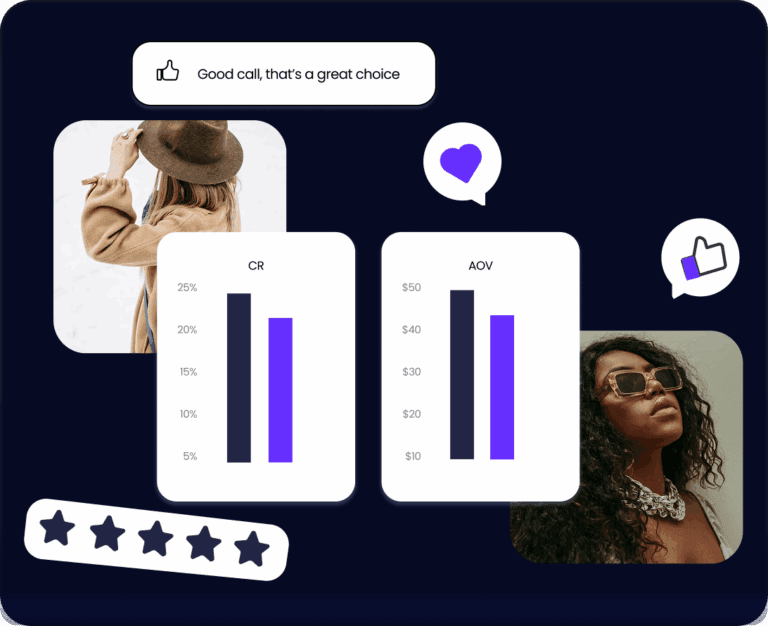Providing valuable information in online shops (informational nudging) can help visitors make better-informed and more conscious purchase decisions leading to fewer product returns.¹
Even when showing additional information can also evoke some kind of friction, online visitors will not necessarily break up their journey. What we find in our data is that behavioral nudges helping online shoppers reflect on their decisions can actually increase the conversion rate. The reason for this is that having people reflect can make them commit even more to their purchase intention.²
behamics utilizes thousands of behavioral nudges intelligently across the entire customer journey in order to drive shopping behavior that leads to fewer product returns and more conversions.
One of these nudge solutions, namely to give visitors advice on the fit of an article (actually not one of the most innovative ones) led to quite interesting results.
Based on large-scale transactional data of a German fashion online retailer including orders, returns and customer feedback, the behamics AI predicts whether an article is larger or smaller than usual. If this was the case the corresponding information was displayed on the detail pages of the respective products (see Figures 1 and 2). In addition, there were two control groups with visitors of the same products that did not receive the respective fit nudges.

Figure 1: Fit nudge “Runs larger”

Figure 2: Fit nudge “Runs smaller”
Many fashion retailers and sizing tools already have such procedures in place. What is more interesting, though, is how these informational nudges influenced the purchase and return behavior of customers.
Contrary effects through different fit nudges
We analyzed the behavioral effects of both nudges over two months, resulting in a sample of more than 95’000 page visits with over 9000 orders in total.
Compared to the control group, the “Runs larger” (Figure 1) nudge increased the conversion rate by 6.2% (9.1% vs. 8.5%) and reduced the return rate by 4%, from 59.5 to 57.1% (Confidence >90%).
In contrast, the “Runs smaller” nudge (Figure 2) decreased the conversion rate by 5.4% (9.7% vs. 10.3%) and increased the return rate by 0.7% (53%) compared to a control group (52.6%) that did not received this fit nudge (Confidence >90%, see Figure 3).

Figure 3: Behavioral effects of the fit nudges
Why do fit nudges lead to contrary results?
Apparently, people seem to feel more comfortable when realizing that the item “runs larger” and might fit them even in a smaller size. And this positive feeling increases how well the article is liked, resulting in a higher conversion rate.
In contrast, the information that the item “runs smaller,” containing the recommendation to order a larger size, seems to make visitors feel uncomfortable. They would rather abstain from an order, resulting in a lower conversion rate compared to visitors who do not receive this fit advice.
What’s more interesting is that those feelings seem to hold even until the actual decision on whether to keep or return the product(s) takes place. Although neither nudge has a higher informational value, the “runs smaller” advice even leads to a higher return rate than receiving no fit nudge, whereas the “runs larger” nudge decreases the return rate compared to receiving no fit nudge.
This seems to indicate two effects: First, customers who ordered the article in a smaller size because of the “bigger” nudge might be flattered and feel good when it fits them even in a smaller size. However, customers who received a “smaller” nudge and ordered their preferred article in a bigger size than usual might experience negative feelings when trying on the article, e.g. feeling not in shape.
Second, customers who ordered their usual size as a consequence of the “bigger” nudge seem to like the feeling of a loose fit as a consequence of a larger-than-usual article more than customers who ordered their usual size after the “smaller” nudge like the feeling of a slim fit resulting from a smaller-than-usual article.
These effects indicate that providing fit and size information does not always prevent product returns, and can even backfire. Beside the functional value fit advices also have an emotional effect that can elicit feelings of discomfort decreasing conversions and later increasing the return rate.
Using informational nudges intelligently
These results indicate that it can be useful to target fit nudges differently depending on your product and customer segments. For instance, according to these results it can be helpful to communicate proactively that an article is larger because it can elicit positive feelings, leading to higher conversions and less product returns. In contrast, fit advice for smaller items should be communicated either in a more reserved or even in an alternative way: for example, referring to customer service instead of telling customers proactively to order in a bigger size.
In order to optimize conversion and return rates, fashion shops need to communicate their product and fit information in a way that resonates with the individual customer. In addition, fashion retailers need to reduce post-purchase dissonance by making clear to their customers why they made the right decision, especially when this decision includes products in a larger size than usual.
If you want to learn more about how you can optimize revenues while lowering return rates by targeting behavioral nudges intelligently, reach out to us here.
1 Pfrang, Th. (2016): Behavioral Appeals to Influence Product Return Behavior – Theoretical Foundations and Experimental Applications, University of St.Gallen.
2 Bucher, A (2020): Designing for Behaviour Change, Rosenfeld Media


